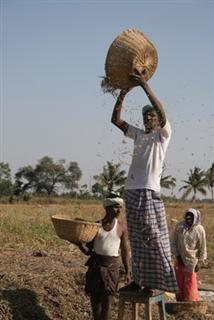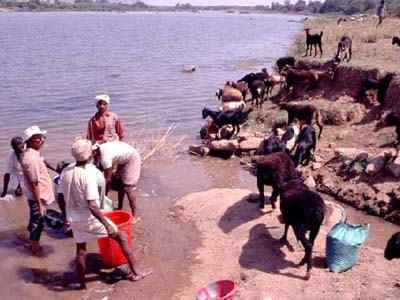|
South Deccan Prehistory Project
Research Background
Project Team
Training
Publications
Media and Blogs
Protection of Sites and Monuments
Past Events
Acknowledgements New Museum
Sub Projects
Origins of Agriculture in South India
Bellary District Archaeological Project
Sanganakallu-Kupgal Project
Ashmounds of South India
(photo gallery & gazetteer)
Web Links

winnowing Cajanus cajan.
Photo by J.A. Soldevilla
|
|
The Archaeobotany
of South India and Agricultural Origins
The
origins of agriculture represents a fundamental change in
human economies that impacts social organization, demography
and perception of the landscape. In South India this is traced
toi the Southern Neolithic, which has long provided evidencefor
the earliest pastoralism in Peninsular India. The wellknownsite
category of the Southern Neolithic is the ashmound,which has
been shown to be an accumulation of animal dung at ancient
penning sites.
In
Northern and Eastern Karnataka, there are two important categories
of Neolithic sites. Permanent habitation sites, where agriculture
was practised, were often located on the peaks of granite
hills that punctuate the plains of Karnataka (see photo below).
In addition there are enigmatic 'ashmound' sies which consist
of large, heaped accumulations of burnt cattledung, the largest
some 8 meters in height and some 40 meters in diameter. Archaeological
evidence from a couple of the ashmounds indicates that they
are sites of ancient cattle penning where dung was  allowed
to accumulate and periodically burnt, perhaps in seasonal
rituals. The ashmound sites were encampemnts for the movement
of pastoral groups tied to the agricultural production at
the more permanent sites. allowed
to accumulate and periodically burnt, perhaps in seasonal
rituals. The ashmound sites were encampemnts for the movement
of pastoral groups tied to the agricultural production at
the more permanent sites.
An
important part of the research in this project has been archaeobotany
(or paleoethnobotany). Archaeobotanical sampling and analysis
has been carried out by Dorian
Fuller since 1997, and continues, including research by
students and post-doctoral colleagues. Work on the plant remains
from the hilltop village sites, or non-ashmound layers within
sites, has established that subsistence focused on the cultivation
of small millet-grasses (including browntop millet, Brachiaria
ramosa, and bristley foxtail grass, Setaria verticillata)
and pulses (mung bean, Vigna radiata, and horsegram, Macrotyloma
uniflorum). These crop species are native to Southern
India and were probably domesticated in the wider region,
although within the actual granitic landscape of the Ashmounds.While
horsegram and the millets can be found in the savannah environments
like that of the ashmounds, with wild mungbean is restricted
to moister forests such as in the Western Ghats and parts
of the Eastern Ghats. This evidence raises the likelihood
that South India was an independent centre of plant domestication
in the middle Holocene, perhaps ca. 5000 years ago (which
has been discussed in several papers by
Fuller and others). In addition there is evidence
for the use of as yet unideintified tuber foods.

During
the course of the Neolithic a number of other crops deriving
from other regions were introducted. The chronology of these
introductions is now supported by direct radiocarbon dating
of grains. Introductions include Wheat (Triticum diococcum and
free-threshing wheat) and Barley (Hordeum vulgare),
derving from the northwest, were adopted 2000-1900 BC. Somewhat
later crops of African origins, the Hyacinth Bean (Lablab
purpureus) and Pearl Millet (Pennisetum glaucum),
by ca. 1500 BC.
Bucket flotation being carried out at Hallur
in 1998. Professor
Ravi Korisettar supervises.
From
2003-2006,
with the support of the Leverhulme Trust, research has been carried
out on the wood charcoal from Southern Neolithic sites,
principally by Dr. Eleni
Asouti. This research has required detailed background research
in wood
anatomy and vegetation ecology, as well as ethnobotany will
will soon be available in a the book Trees and Woodlands of
South India: An Archaeological Perspective by Eleni Asouti
and Dorian Q Fuller, published by Left
Coast Press, and in India by
Munshiram Manoharlal.
 Archaeological
examples of the most common seeds on Southern Neolithic sites,
clockwise from top left: Brachiaria ramosa, Vigna radiata,
Macrotyloma uniflorum, Setaria verticillata. Archaeological
examples of the most common seeds on Southern Neolithic sites,
clockwise from top left: Brachiaria ramosa, Vigna radiata,
Macrotyloma uniflorum, Setaria verticillata.
Other important evidence
includes wood charcoal that suggests the beginnings of tree
cultivation towards the end of the Neolithic, 1400-1300 BC,
including Citrus (probably the citron), and mangos.
Charcoal from sandalwood testifies to the beginnings of trade
in this important aromatic timber, which has long been important
in South India, although it may have been introduced originally
from Indonesia. In addition seed findes of the bengal madder
(Rubia cordifolia) suggest exploitation of plants for
dyes, which may be linked the the emergence of textile production
after 1700 BC, but esepcially in the later Second Millennium
BC. This is indicated by finds of spindle whorls, while charred
seeds of cotton and flax have been found at the site of Hallur
from 1000-900 BC.
(For further information,
see thre publications by Fuller or Asouti: goto
references). also: earlier
webpages on this research.
|
|
.jpg)
.jpg)